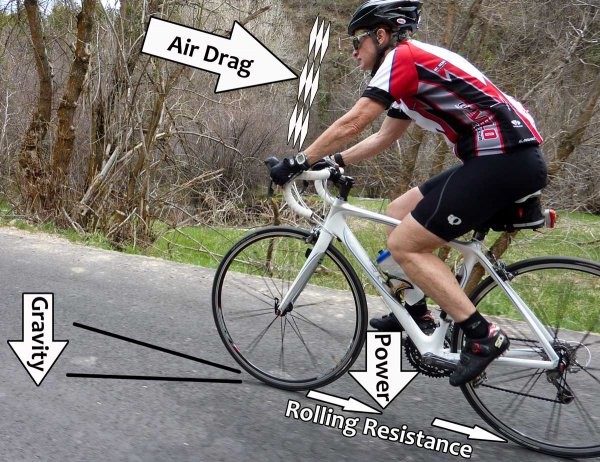How to cycle faster is a topic that most cyclists can relate to. The best advice is just to train harder or longer or both. But there are other things that come into play. Some things you can do nothing about. Some require only a bit of attention and others can require a great deal. Here are 10 things that can slow you down which you can address to cycle faster.
The Big Thing That Slows You Down
Drag is the single biggest thing keeping you and your bike from going infinitely fast on flat ground. Drag is the sciency term for a force that pushes backwards along your line of travel. Your bike is subject to different sources of drag.
Kind of a Drag
Mechanical drag is friction from your chain along with bearings in your wheels and bottom bracket. Mechanical drag is also the result of tire drag or rolling resistance caused by the constant squashing of the tires against the road.
No. 1 Mechanical Drag
Mechanical drag is pretty much a small, fixed number. It hardly varies from bike to bike but more so between cheaper bikes and high-end bikes. But even expensive ceramic bearings do very little to make a noticeable dent in mechanical drag. The chain is the biggest source of mechanical drag and there haven’t been any real advances in reducing chain drag recently because the contemporary roller chain is remarkably efficient. Basically, the main thing you can do to minimize drivetrain drag is to keep your bike properly maintained and your chain oiled.
No. 2 The Contact Patch
Tires are one of the single biggest things that can slow you down and here’s why. A pneumatic tire has a flat spot where it touches the ground, aka the contact patch. About half your weight is on each tire, making the contact patch a little smaller than 1-inch square in size. As the tire rolls forward, the leading edge of the contact patch moves around. Rubber is bent and flattened. As the tire rotates it bends over and over again. The constant bending involves friction that adds up and slows you down. Not much you can do about it except for keeping your tires topped off before every ride.
No. 3 Tire Osmosis
No. 4 Hard Tires
No. 5 Wide Tires
The most common size of road tire is 23mm. However, the trend to run wider 25mm tires is growing. If you’re an experienced road rider, you might notice that 25’s handle different, maybe a bit more stable, particularly through corners, but they can be slower on smooth surfaces although it might be unnoticeable. In general, the wider the tire, the more rubber that has to be flattened on each revolution of the wheel. 23’s are the preference of racers for a reason.
N0. 6 Clunky Shifting
No. 7 Added Weight
This one’s a no-brainer and has been drilled into cyclist’s heads for decades. Things you may have missed though are tools in your toolkit, added water bottles full of water, or extra gear in your jersey. One often overlooked heavy item is wet clothes. Even a light sprinkle can add weight to fabrics.
No. 8 Floppy Clothes
There’s a reason why cyclists wear tight clothes. It’s because unnecessary flappy clothes give you an aerodynamic disadvantage. This one can be fairly significant. If you can hear it or see it, it’s slowing you down. Tuck it in or discard it and get a skin tight jersey. It will help you cycle faster with the least amount of effort.
No. 9 Upright Position
Some road bikes have two torso positions; aggressive and passive. It’s typically controlled by the stem that angles up or down as needed. If you’re riding in the passive or upright position, your torso is catching the wind and slowing you down. Remedy it by removing the stem and flip it upside down for the aggressive position. If you have a flat stem and it won’t flip, consider swapping it for an angled one. (See “Handlebar Setup in How to Do a Proper Bike Fit)
No. 10 Air Temperature
Physiologically, depending on the distance of the ride and the temperature, your leg muscles may not be operating at full potential if it’s cold outside. A one-percent decline in local muscle temperature can reduce muscle force by up to 10 percent. On the opposite end of the scale, higher temperatures cause overheating and should also be avoided if you’re trying for a speed record. Additionally, air density is also affected by temperature, pressure, and also by humidity. Temperature has a more pronounced effect on air density than humidity — cold air contains more molecules per cubic meter. For example, on a cold day, you need to work harder to maintain the same speed because the air density is higher than on a warm summer day.
